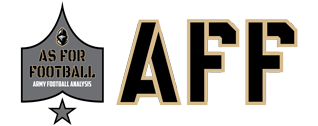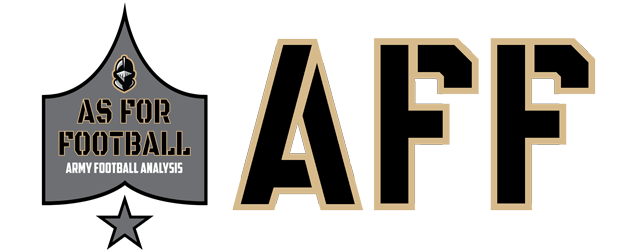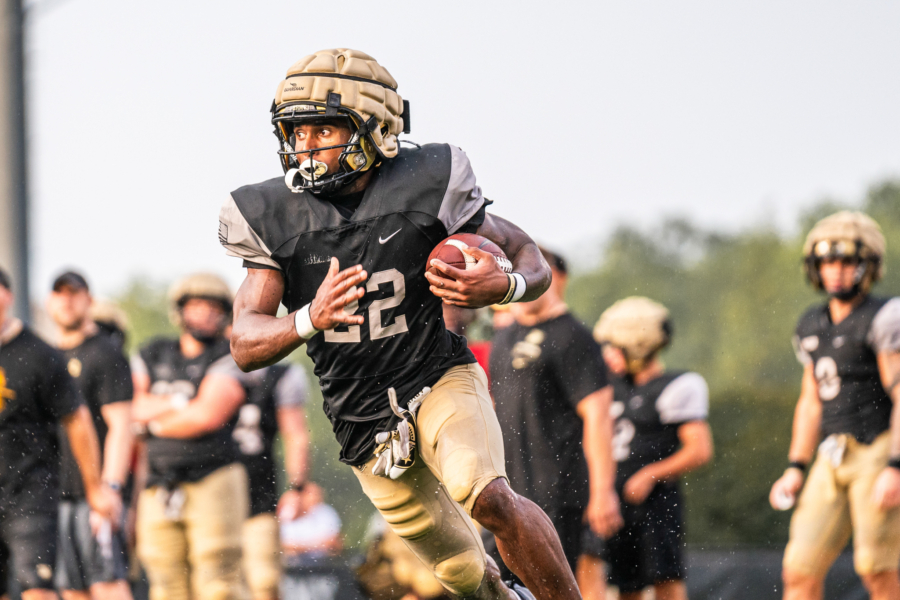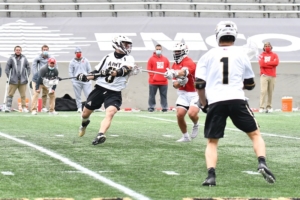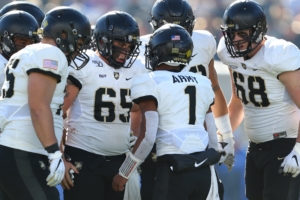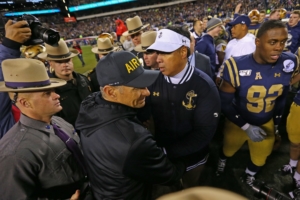Well we’re a little over a week out from Army Football’s first game of the season. Our normal feelings of excitement and anxiety have been multiplied this year by the prospect of seeing the Black Knights’ new offense. We here at As For Football are BIG fans of keeping up that excitement, but our goal is to alleviate some of the anxiety by helping us all to understand what we’re gonna see when Army’s offense takes the field this season.
— Army Football (@ArmyWP_Football) August 24, 2023
If you haven’t read the first article in this series, “Army’s Offense: Why the Switch?”, go read that one first.
A Few Ground Rules…
- This article is not meant to be an in-depth guide to Army’s new scheme. None of the AFF staff have ever coached a football team, nor do we have access to game or even practice tape. The information we’re bringing to you is all publicly available. The aim of this article is to help Army fans apply what they know about the traditional flexbone triple-option — before recent rule changes — so that we can all see the similarities and differences with the new offensive approach.
- This is based on Offensive Coordinator Drew Thatcher’s previous work. However, there is no guarantee that Army is going to run a carbon copy of Thatcher’s previous scheme. Just because Army brought Coach Thatcher in doesn’t mean there won’t be changes.
There probably WILL be changes.
- We’ll be going through a standard play from a standard set against a standard 4-2 box defense. We’re not going to get into the details of the perimeter blocking scheme, passing plays, or any other variations from that one standard. Just like the flexbone, the new offense will have different formations incorporating a variety of different concepts. But we’re going to take this one step at a time!
- The playcharts below are by no means exhaustive. For example, the blocking assignments for the offensive linemen aren’t depicted. Only the portions of the play that are relevant to understanding the scheme are shown.
Now that we know what we’re attmepting here, let’s get into it!
Our 2023 Media Guide is Live!
— Army Football (@ArmyWP_Football) August 21, 2023
→ https://t.co/vzlBJgfwnT#GoArmy pic.twitter.com/2Cdrcmyvmm
The Snap
We’ve all heard that Army will be using the shotgun this year. Our previous article explained why and the advantages offered by that look. For now, let’s assume that we have a standard triple option play going to the left. Here’s a snapshot at what each offense would look like at the moment the quarterback receives the snap:
Difference #1
Hiding your cards. In the flexbone, by the time the quarterback receives the snap, the right side running back is already in motion. While there are different formations in the gun option which could have a player in motion, there is also an ability to prevent that. This prevents the linebackers from being able to cheat one way or the other without running some sort of reverse as a tendency-breaker.
Difference #2
Fullbacks. In the flexbone the running back behind the quarterback is typically a 220+ pound fullback. In the gun option, all three running backs tend to be little lighter and faster. This allows for extra deception in which running back will take which option and/or block.
The Dive Read
Below is a snapshot from soon after the snap when the quarterback must make his decision on whether to give the ball to the dive option or keep the ball and head to the perimeter.
Difference #3
The angle. The quarterback must make a read on the defensive end (blue circle). The end is going to charge at the quarterback/running back exchange and the quarterback must decipher whether the end will try to tackle him or the running back. In the flexbone play, the quarterback must turn his head to be able to make a good read. In the gun option, the angle from center is much smaller, so the end will be in the quarterback’s view sooner and for longer.
Difference #4
Time. In the flexbone, the quarterback has a fraction of a second to make this read. In the gun option, the end will be a few yards further away. That gives the quarterback a valuable extra second or even more to make that first read.
Difference #5
Read block. In the flexbone, the dive read is only slowed down on his way to the mesh by an initial brush from the left tackle. But that left tackle typically has another blocking assignment. In the gun option, the defender can be slowed by both the tackle and a blocking running back. That running back is eventually going to block a linebacker, but he can chip to temporarily delay the defensive end, too.
Difference #6
Development time. In the extra second or two that all of this takes place, the offensive line’s blocks have been initiated. If the quarterback decides to hand the ball off, the running back will be able to pick which gap is most open, rather than the gap being decided before the play.
The Pitch Read
Assuming the defensive end goes after the running back and the quarterback goes to the perimeter with the ball, he’ll have to make a read on the edge. We he keep or pitch to the second running back?
That moment looks like this:
Before we get into the difference, it’s important to point out one similarity. Even though the quarterback takes an extra second to make the dive read, he’s not getting to the perimeter any slower. The time he would have spent turning or running backwards in the flexbone is instead spent making a read. In the gun option he’s still heading for the sideline as quickly as he would have in the flexbone.
Difference #7
Ahead of the curve. The pitch option running back is able to get to the perimeter faster because he starts near the quarterback rather than where you might otherwise find a tight end. This allows him to do 2 things. First, he can position himself better as the play develops. Second, provided the angle is available, he can get himself ahead of the quarterback (not pictured). This means that a dropped pitch would be an incomplete pass rather than a fumble.
CBS Sports has released its announcer lineup for the 2023 College Football season.
— CBS Sports PR (@CBSSportsGang) August 16, 2023
Coverage begins Saturday, Aug. 26 with ‘Week Zero’ on @CBSSportsNet while CBS and @paramountplus kick off Week 1 with two Big Ten matchups.
Full release: https://t.co/F8VXI2CV7F pic.twitter.com/TIa3a5MUR2
What’s Different Now?
If you read our previous article on the offense, you know that the gun option is different from the one you’ve seen used as a gimmick mostly in CiC games. Why? Because the team is now training specifically for the shotgun snap and the new dive read as well as utilizing the perimeter much more consistently.
But looking at the 300 meter target rather than 50 meter offers the following realization:
The week or two before a rivalry game, it’s extremely difficult to retrain players in even one or two things. In this article alone, we’ve listed seven differences. And those don’t account for all of the new blocking schemes, receiving routes, and other variations you might see this year. We showed just a part of the basics. A schematically sound gun option takes more than a week or two to deploy properly. It takes a full offseason, at least.
2023 Army Football Schedule
— 𝙱𝚛𝚒𝚐𝚊𝚍𝚎 𝚁𝚎𝚟𝚒𝚎𝚠 (@BrigadeReview) August 12, 2023
Retro logos only! pic.twitter.com/HcOaNuPBKx
Going Forward
Despite all of the changes we’ve discussed today, there are more similarities than differences between the flexbone and the new gun option. So don’t let anyone tell you that Army is “leaving the triple option.” They’re not. You’re still going to have a dive read and a pitch read. The execution will just look a little different.
If you’re expecting this to be a seamless transition, don’t. There will be growing pains. We would also caution you about being too pessimistic. We’ve all heard reports about the offense being behind the defense in fall camp. But ask yourself, when was the last time that wasn’t the case?
It’s probably been decades.
We’ve crossed the Rubicon at this point and we should be glad that Jeff Monken and Mike Buddie decided to go all in rather than half-ass it. So get with it, or get out of the way!
Don’t Miss As For Football’s Preseason Series
— Army Football Preview: 2023 Season Preview (First Quarter)
— Army Football Preview: 2023 Season Preview (Second Quarter)
— Army Football Preview: 2023 Season Preview (Third Quarter)
— Army Football Preview: 2023 Season Preview (Fourth Quarter)
— Analyzing Army’s Appearance on NFL Network
— A Few Favorite Pics from the 2022 Season
— Army Football Preview: Defense & Special Teams
— Army’s New Offense: Why the Switch?
— PAC-12 Dissolution Sours Independence Bowl Deal
— Michie Stadium: Blaik Field’s Endzone History
— As For Football’s Guide to Michie Stadium (2023 Edition)
